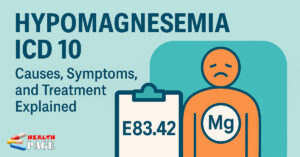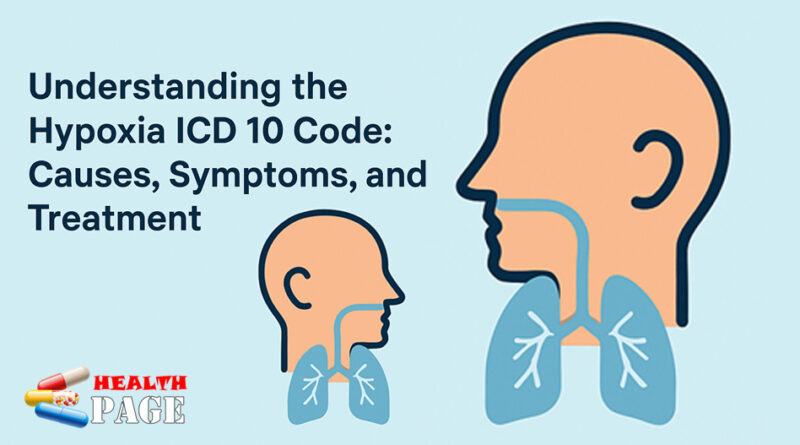Understanding the Hypoxia ICD 10 Code: Causes, Symptoms, and Treatment
Hypoxia is a condition where the body lacks enough oxygen. It can affect organs and body tissues.
The hypoxia ICD 10 code is used by doctors and hospitals to document this condition. It helps with accurate medical records and insurance billing.
Knowing the hypoxia ICD 10 code ensures correct diagnosis and treatment. It also supports better communication between healthcare providers.
This article will explain what causes hypoxia, its symptoms, and how it is treated. We will also look at how the ICD 10 code system works.
Understanding the hypoxia ICD 10 code can help patients and caregivers know what to expect. It also improves awareness and helps with early detection.
Below is a quick overview of key areas covered in this article:
| Section Title | Details Included |
|---|---|
| Causes of Hypoxia | Health issues, environmental factors |
| Symptoms of Hypoxia | Early and advanced signs |
| Treatment Options | Oxygen therapy, medications, emergency care |
| Understanding ICD 10 Codes | How codes are assigned and used |
| Importance in Medical Records | Accuracy in diagnosis and billing |
Stay with us to learn more about this important health topic. We aim to make complex info simple and clear.
What is Hypoxia?
Hypoxia is a medical condition where the body or a part of the body does not get enough oxygen. Oxygen is vital for cells to create energy and function properly. Without enough oxygen, organs and tissues can become damaged.
When hypoxia occurs, the brain, heart, and other vital organs are the first to suffer. This can lead to confusion, fatigue, shortness of breath, and even organ failure if not treated.
Types of Hypoxia
There are several types of hypoxia. Each one affects the body in a different way:
1. Hypoxic Hypoxia
This is the most common type. It happens when there is not enough oxygen in the air or lungs. It can occur at high altitudes or with lung diseases like asthma or pneumonia.
2. Histotoxic Hypoxia
In this type, the cells in the body are unable to use oxygen. This often happens due to toxins, such as cyanide. Even if oxygen is available, the cells cannot use it properly.
3. Stagnant Hypoxia
Here, blood flow is reduced or blocked. This prevents oxygen-rich blood from reaching the tissues. Conditions like heart failure or shock can cause stagnant hypoxia.
Understanding these types helps doctors choose the right treatment. Early diagnosis is key to preventing serious complications.

Understanding the Hypoxia ICD 10 Code
The ICD 10 coding system is used worldwide in healthcare. It stands for International Classification of Diseases, 10th Revision. This system helps doctors and hospitals record medical conditions in a standard way.
Each disease or condition has its own unique code. These codes are used for medical records, insurance claims, and treatment plans.
ICD 10 Code for Hypoxia
The specific ICD 10 code for hypoxia is R09.02.
This code falls under the category:
R00–R99 – Symptoms, signs and abnormal clinical and laboratory findings, not elsewhere classified.
Code R09.02 refers to Hypoxemia, which is low oxygen in the blood. It is often used to document hypoxia, as both terms are closely related in clinical settings.
Why Accurate Coding Matters
Accurate use of the hypoxia ICD 10 code is very important. Here’s why:
- Correct Diagnosis: Ensures the patient gets the right treatment.
- Insurance Billing: Helps insurance companies process claims properly.
- Medical Records: Keeps health records clear and organized.
- Research and Statistics: Helps track health trends and plan public health responses.
Mistakes in coding can lead to denied insurance claims or incorrect treatments. That’s why healthcare providers must use the correct ICD 10 code every time.
Using the right hypoxia ICD 10 code supports quality care and avoids costly errors.
Causes of Hypoxia
Hypoxia can happen for many reasons. It may result from medical conditions, environmental factors, or problems with blood flow or oxygen use.
Common Medical Conditions
Several health issues can cause hypoxia, including:
- Chronic lung diseases like asthma, COPD, or pneumonia
- Heart conditions such as heart failure or blocked arteries
- Blood clots in the lungs (pulmonary embolism)
- Sleep apnea, which disrupts breathing during sleep
These conditions reduce the lungs’ ability to take in and deliver oxygen.
Environmental Causes
The environment can also lead to hypoxia. Common causes include:
- High altitudes where air has lower oxygen levels
- Poorly ventilated spaces, especially in enclosed areas
- Smoke inhalation during fires
At high elevations, the body may struggle to adjust, leading to symptoms like dizziness or shortness of breath.
Anemia and Respiratory Failure
- Anemia reduces red blood cells, which carry oxygen. Even with normal breathing, tissues may not get enough oxygen.
- Respiratory failure occurs when the lungs can’t remove carbon dioxide or supply enough oxygen. This is a severe and life-threatening cause of hypoxia.
Understanding the cause of hypoxia is key to choosing the right treatment. Identifying and treating the root problem improves oxygen levels and health outcomes.
Symptoms of Hypoxia
Recognizing the signs of hypoxia early can help prevent serious health problems. Symptoms may range from mild to life-threatening.
Early Warning Signs
Early symptoms of hypoxia often appear when oxygen levels begin to drop. These may include:
- Dizziness or lightheadedness
- Confusion or trouble concentrating
- Shortness of breath, especially during activity
- Headache
- Fatigue or feeling very tired
- Rapid heartbeat
These signs are the body’s way of signaling that it needs more oxygen.
Severe Symptoms
If hypoxia gets worse, more serious symptoms can develop. These may include:
- Cyanosis – a bluish tint to the skin, lips, or nails
- Rapid breathing or gasping for air
- Chest pain
- Unconsciousness or fainting
- Seizures in extreme cases
These symptoms need immediate medical care. They can signal a life-threatening lack of oxygen.
Symptoms by Type of Hypoxia
Symptoms may vary depending on the type of hypoxia:
- Hypoxic hypoxia often causes shortness of breath and fast breathing.
- Histotoxic hypoxia may show confusion, despite normal breathing.
- Stagnant hypoxia may lead to cold, pale, or bluish limbs due to poor blood flow.
Paying attention to these signs can lead to faster diagnosis and treatment. Early care can prevent damage to vital organs like the brain and heart.
Diagnosis and Medical Testing
Doctors diagnose hypoxia by checking symptoms and using special tests to measure oxygen levels in the body.
How Hypoxia Is Diagnosed
The first step is a physical exam and a review of symptoms. Doctors look for signs like confusion, bluish skin, or rapid breathing.
They may ask about medical history, recent illnesses, or exposure to high altitudes or toxins.
Key Tests Used
Several tests help confirm a hypoxia diagnosis:
- Pulse oximetry: A small device placed on the finger that shows oxygen levels in the blood. Normal levels are 95% or higher.
- Arterial blood gas (ABG) test: A blood sample from an artery to measure oxygen, carbon dioxide, and pH levels. It gives a more detailed look at breathing problems.
- Imaging tests: Chest X-rays, CT scans, or MRIs may be used to check the lungs and heart for underlying issues.
- Electrocardiogram (ECG): This test checks heart function, which can affect oxygen flow.
Role of ICD 10 Coding
Once hypoxia is confirmed, doctors use the hypoxia ICD 10 code (R09.02) to record the diagnosis.
This code helps in:
- Organizing patient records
- Ensuring proper insurance billing
- Tracking disease patterns and treatment outcomes
Accurate diagnosis and coding lead to faster treatment and better care.
Treatment Options for Hypoxia
Treating hypoxia means restoring normal oxygen levels and addressing the root cause. Treatment depends on how severe the condition is and what caused it.
Oxygen Therapy
Oxygen therapy is the most common treatment for hypoxia. It delivers extra oxygen to help the body function better.
It may be given through:
- Nasal cannula (small tubes placed in the nose)
- Face mask
- Mechanical ventilator (for severe cases)
Oxygen therapy is needed when oxygen levels drop below 90%. It is often used in hospitals, during emergencies, or at home for chronic conditions.
Medications for Underlying Causes
Treating the cause of hypoxia is also important. Common treatments include:
- Inhalers or steroids for asthma and COPD
- Antibiotics for lung infections like pneumonia
- Iron supplements or blood transfusions for anemia
- Blood thinners for clots in the lungs (pulmonary embolism)
Proper medication helps the body use oxygen more efficiently.
Lifestyle Changes
Certain lifestyle habits can help manage and prevent hypoxia:
- Quit smoking to improve lung health
- Exercise regularly to strengthen the heart and lungs
- Eat a balanced diet to prevent anemia
- Avoid high altitudes if you are sensitive to low oxygen
- Use oxygen support as prescribed by your doctor
Managing chronic conditions and staying healthy lowers the risk of hypoxia. Always follow your doctor’s advice for long-term care.
Complications of Untreated Hypoxia
Untreated hypoxia can lead to serious health problems. Without enough oxygen, the body’s organs cannot work properly.
Effects on the Heart and Brain
The heart needs oxygen to pump blood. Low oxygen forces it to work harder, which may lead to:
- Irregular heartbeats
- Heart failure
- Heart attack
The brain is highly sensitive to oxygen loss. In just minutes, low oxygen can cause:
- Confusion and memory loss
- Poor coordination
- Loss of consciousness
Severe and prolonged hypoxia can result in permanent brain damage.
Long-Term Risks
If hypoxia is not treated quickly, it can lead to life-threatening complications such as:
- Respiratory failure – when the lungs can no longer deliver enough oxygen
- Organ failure – including kidney and liver damage
- Coma or death – in extreme and prolonged cases
These outcomes highlight the need for fast diagnosis and treatment.
Role of ICD 10 Coding in Timely Care
Using the correct hypoxia ICD 10 code (R09.02) helps ensure quick and accurate medical care.
- Doctors can identify the condition faster
- Hospitals can provide the right treatment
- Insurance claims are processed without delay
Proper coding improves communication among healthcare teams. It also ensures the patient gets the care they need when it matters most.
Prevention Strategies
Preventing hypoxia involves healthy habits, regular checkups, and proper management of existing health conditions.
Healthy Habits to Prevent Hypoxia
Simple lifestyle changes can help keep your oxygen levels normal:
- Avoid smoking to protect your lungs
- Exercise regularly to improve lung and heart strength
- Eat iron-rich foods like leafy greens and lean meats to prevent anemia
- Stay hydrated to support blood flow and oxygen delivery
- Practice deep breathing to strengthen lung function
These habits support better oxygen use and overall health.
Reducing Risks for Chronic Patients
People with chronic conditions need to take extra care. They can reduce the risk of hypoxia by:
- Taking medications as prescribed
- Using oxygen therapy if recommended
- Avoiding high altitudes and polluted environments
- Attending regular doctor visits
- Monitoring symptoms like shortness of breath or fatigue
Staying on top of treatment plans helps manage the condition and lowers the chance of oxygen problems.
Role of ICD 10 Coding in Prevention
Doctors use the hypoxia ICD 10 code (R09.02) not just for treatment, but also for preventive care.
- Tracks patient history for early warning signs
- Helps in routine screenings for at-risk patients
- Supports insurance coverage for preventive services
Accurate ICD 10 coding ensures patients get timely advice and care. This improves outcomes and prevents serious complications.
Conclusion
Hypoxia is a condition where the body doesn’t receive enough oxygen, which can lead to serious health issues like heart and brain damage. Early symptoms include dizziness, confusion, and shortness of breath, while severe cases can result in unconsciousness and cyanosis (blue skin).
Treatment for hypoxia often involves oxygen therapy, medications to treat underlying causes, and lifestyle changes to improve overall health. For those with chronic conditions, managing symptoms and seeking regular medical care is essential.
Using the correct hypoxia ICD 10 code (R09.02) is crucial for accurate diagnosis, treatment, and billing. It ensures that patients receive proper care and helps healthcare providers track patient progress and complications.
If you notice any symptoms of hypoxia, such as difficulty breathing or confusion, it’s important to seek medical advice promptly. Early detection and treatment can prevent serious complications and improve health outcomes.


